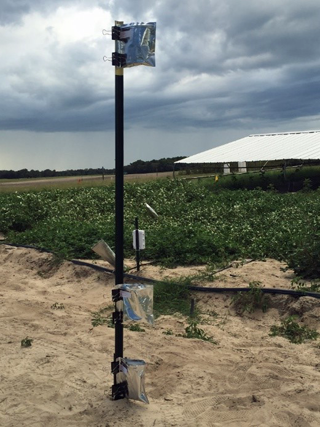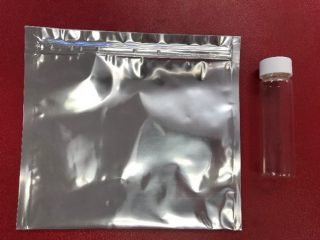Yu-Chien Tseng, Brendan Zurweller and Diane Rowland, UF/IFAS Agronomy Department
Growers typically use indirect methods to sense crop stress, such as soil moisture sensors to predict crop drought stress or models to predict disease risk. Directly monitoring the stress levels experienced by the crop would give an immediate snapshot of crop condition, and allow growers to quickly respond through irrigation or other management options to solve the issue. But few technologies are available to detect stress quickly and accurately directly from the plant.
Recently, a promising area of research has focused on the detection of volatile organic compounds (VOCs) from crops as an indicator for stress levels. VOCs are organic chemicals released in gas form by plants through leaves, stems, and roots. The types and amounts of VOCs released from plants change as stress develops. We now know that VOCs sometimes act as signals between plants, sending out a “stress alarm” that may activate defenses in their neighbors. Plant VOCs are also known to signal beneficial insects, attracting them to come and fight against more harmful insects. Most recently, VOCs are being considered as early warning detection for drought stress.

Figure 1: There were rainout shelters and soil moisture sensors on the peanut field at the Plant Science Research & Education Unit near Citra, FL.
Information about the kinds and amounts of VOCs that may act as stress signals in peanut is currently not available, but could be very beneficial for precision irrigation recommendations for managing drought in peanut. Scientists from the University of Florida’s new Center for Stress Resilient Agriculture, and the Georgia Tech Research Institute have teamed up to identify and design collection methods for VOCs associated with drought in peanut. Utilizing rainout shelters (Figure 1), and controlled environment chambers to simulate drought conditions at certain times during the season, the team is working to develop a “breathalyzer test” for peanut drought stress. They envision this test would provide early detection of drought stress in the plant and could be important for a variety of applications, such as improving irrigation scheduling, or preventing aflatoxin.

Figure 3: VOC collection beside the peanut research field located at the Plant Science Research and Eucation Unit near Citra, FL.
The preliminary results show that different peanut growth stages, and even time of day, impact the amounts and types of VOCs released from peanut plants. Peanuts also have different patterns of VOCs depending on the level of stress. Experiments with the type of collection methods (Figure 2) have also identified methods that might be easily utilized by growers, so that eventually growers may deploy collection devices in fields or directly on plants (Figure 3). University of Florida and Georgia Tech researchers are continuing to validate the feasibility of using these approaches for farm management through ongoing lab and field experiments planned for the 2018 season. These methods would potentially be sensing stress directly from the crop, providing more accurate and timely intervention opportunities.
—
- Rapid Response Team Deployed to Investigate Peanut Collapse - September 21, 2018
- Developing a “Stress Breathalyzer” for Peanuts - April 13, 2018
- Peanut Nodule Analysis to Assess Crop Health - August 18, 2017

